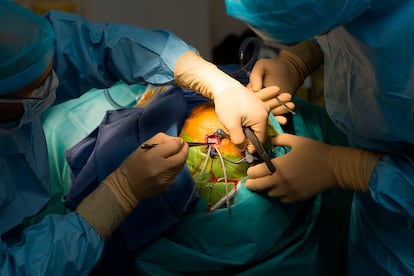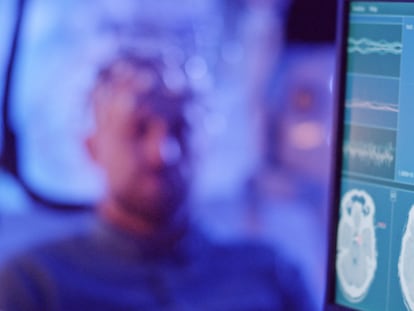New technique improves memory by stimulating the brain without surgery
Temporal interference could provide an alternative to DBS, which has been very successful in some cases of Parkinson’s disease and epilepsy, but requires electrodes to be surgically implanted

Mental illness is the leading cause of disability in advanced countries. More than 30% of long-term sick leave concerns brain ailments, and treatments only achieve limited results. In cases like Alzheimer’s, not even that. Medications for depression or schizophrenia work by raising or lowering the concentration of molecules such as serotonin or dopamine in the brain. But it is an indiscriminate approach, as each disease affects specific brain circuits and the drugs act on all of them. Since the 1980s, deep brain stimulation (DBS) has shown that it can help some people with neurological diseases that still have no cure. By implanting electrodes in very precise areas of the brain, it is possible to measure brain activity and modulate it only in the relevant circuit. The technique has been very successful in people with Parkinson’s disease or epilepsy who don’t respond to medication, and there are studies that suggest it can work for severe depression and schizophrenia. However, DBS is much more expensive than drugs and having brain surgery to implant the electrodes is a frightening prospect.
A few days ago, a team of scientists led by Nir Grossman, a researcher at Imperial College London, published in Nature Neuroscience the results of a technique that aims to achieve effects similar to those of DBS, but without brain surgery. This technique — called temporal inference — does not require electrodes to be inserted into the brain. Placing them on the scalp is enough to generate electric fields that are capable of acting on specific groups of neurons in more or less precise areas of the brain. Ensuring that electromagnetic waves do not activate neurons until they reach the target or adjacent area has been a big challenge for science, as this can produce unwanted effects. Temporal inference overcomes this obstacle by generating two high-frequency electric fields in different directions that do not interact with the neurons. When they cross at the desired point, the frequency amplitude is reduced and the electric field stimulates the targeted brain cells.
To test their idea, Grossman’s team applied it to 20 volunteers, who were all healthy, young college students. Specifically, the experiment stimulated the hippocampus, a region of the brain far from the surface that plays an important role in memory. Although the effect was small, these young people improved their memory, demonstrating that it is possible to act on specific neurons, without the need for surgery and without side effects. The researchers highlight that this type of stimulation has the potential to treat some symptoms of Alzheimer’s, epilepsy and schizophrenia. What’s more, the fact that it is a non-invasive treatment means that it could be considered a tool to improve the capabilities of healthy people.
In order for the technique to be used outside the laboratory, it first of all needs to achieve greater precision. As Grossman explains, “the focus is not the same as what is achieved when you have an electrode inside [the brain].” “We cover larger areas within the brain,” he adds. “In addition, the strength of the electric field that we achieve inside the brain is not the same as with the electrodes.” However, with the strength that can be reached by the implants, it is possible to modify the activity of the neuron to achieve a desired result. With noninvasive stimulation, “you can nudge the neuron slightly in one direction or another,” Grossman explains. “That does not mean that I cannot act on these structures, experiments are being done to suppress tremors in patients, but the mechanism is different.”
Andrés Lozano, a specialist in new therapeutic applications of DBS at the University of Toronto (Canada) who did not participate in the study, points out that this type of technique could help expand the benefits of surgical stimulation. “So far, there are about 250,000 people in the world who have received DBS, but [the technique] is underused. It is estimated that 20% of Parkinson’s patients could improve with DBS, but only 2% receive it,” he says. The cost and invasiveness of the technique drive away the remaining 98%, who could benefit from an alternative such as temporal inference, or the ultrasound stimulation developed by researchers such as Lozano.
In the future, the technique could be used to self-stimulate at home and obtain temporary effects on memory before or after use. Treating tremors in people with Parkinson’s, however, requires continuous stimulation, because once it stops, the tremor returns. This would be one of the challenges it would have to overcome in order for it to be useful for medical problems. Additionally, patients notice an itch during stimulation that could be a problem for its general adoption.
Along with the therapeutic possibilities of acting on the depths of the brain without surgery, the new technique — combined with imaging techniques — could be useful in investigating the processes behind the formation of memories or how we learn.
Sign up for our weekly newsletter to get more English-language news coverage from EL PAÍS USA Edition
Tu suscripción se está usando en otro dispositivo
¿Quieres añadir otro usuario a tu suscripción?
Si continúas leyendo en este dispositivo, no se podrá leer en el otro.
FlechaTu suscripción se está usando en otro dispositivo y solo puedes acceder a EL PAÍS desde un dispositivo a la vez.
Si quieres compartir tu cuenta, cambia tu suscripción a la modalidad Premium, así podrás añadir otro usuario. Cada uno accederá con su propia cuenta de email, lo que os permitirá personalizar vuestra experiencia en EL PAÍS.
¿Tienes una suscripción de empresa? Accede aquí para contratar más cuentas.
En el caso de no saber quién está usando tu cuenta, te recomendamos cambiar tu contraseña aquí.
Si decides continuar compartiendo tu cuenta, este mensaje se mostrará en tu dispositivo y en el de la otra persona que está usando tu cuenta de forma indefinida, afectando a tu experiencia de lectura. Puedes consultar aquí los términos y condiciones de la suscripción digital.











































